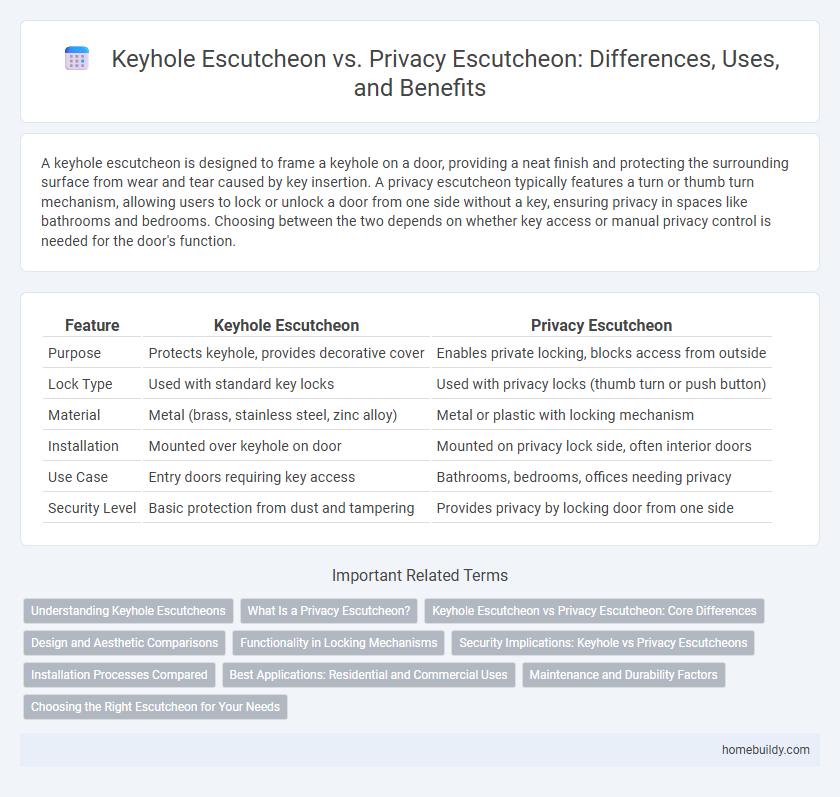A keyhole escutcheon is designed to frame a keyhole on a door, providing a neat finish and protecting the surrounding surface from wear and tear caused by key insertion. A privacy escutcheon typically features a turn or thumb turn mechanism, allowing users to lock or unlock a door from one side without a key, ensuring privacy in spaces like bathrooms and bedrooms. Choosing between the two depends on whether key access or manual privacy control is needed for the door's function.
Table of Comparison
| Feature | Keyhole Escutcheon | Privacy Escutcheon |
|---|---|---|
| Purpose | Protects keyhole, provides decorative cover | Enables private locking, blocks access from outside |
| Lock Type | Used with standard key locks | Used with privacy locks (thumb turn or push button) |
| Material | Metal (brass, stainless steel, zinc alloy) | Metal or plastic with locking mechanism |
| Installation | Mounted over keyhole on door | Mounted on privacy lock side, often interior doors |
| Use Case | Entry doors requiring key access | Bathrooms, bedrooms, offices needing privacy |
| Security Level | Basic protection from dust and tampering | Provides privacy by locking door from one side |
Understanding Keyhole Escutcheons
Keyhole escutcheons are designed to expose the keyhole for traditional key access, commonly used in interior and exterior doors requiring visible key entry. Privacy escutcheons, in contrast, feature a turn or push button mechanism to lock doors from the inside without a visible keyhole, prioritizing privacy over security. Understanding keyhole escutcheons involves recognizing their functional role in allowing key operation and their compatibility with classic door hardware styles.
What Is a Privacy Escutcheon?
A privacy escutcheon is a type of door hardware designed to cover the locking mechanism on interior doors, providing enhanced privacy by preventing access from the outside. Unlike a keyhole escutcheon, which features an opening for key insertion, a privacy escutcheon typically includes a thumb turn or button to lock and unlock the door internally. This makes privacy escutcheons ideal for bathrooms, bedrooms, and other private spaces where easy internal locking is essential without the need for a key.
Keyhole Escutcheon vs Privacy Escutcheon: Core Differences
Keyhole escutcheons feature a traditional keyhole shape designed specifically for cylinder or mortise locks, providing direct access to the key mechanism. Privacy escutcheons, in contrast, are equipped with a turn button or push lock, enabling interior locking without a key for added privacy in bedrooms or bathrooms. The core difference lies in functionality: keyhole escutcheons facilitate secure key entry, while privacy escutcheons offer convenient, keyless locking for personal spaces.
Design and Aesthetic Comparisons
Keyhole escutcheons feature a classic, narrow keyhole shape that emphasizes traditional design elements, often crafted from metals like brass or bronze for a vintage aesthetic. Privacy escutcheons are typically more streamlined and contemporary, with a solid or minimalist cover that conceals the locking mechanism for a cleaner, modern look. The choice between keyhole and privacy escutcheons influences the overall door hardware style, complementing either historic or sleek architectural designs.
Functionality in Locking Mechanisms
Keyhole escutcheons primarily provide access to traditional keyholes, allowing physical key insertion and rotation for locking and unlocking doors, ensuring direct mechanical control over the locking mechanism. Privacy escutcheons are designed for interior doors, featuring a thumb turn or push button that enables locking without a key, prioritizing convenience and quick privacy rather than high security. The functionality difference centers on access control: keyhole escutcheons support keyed locking systems for secure entry, while privacy escutcheons offer simple, tool-free engagement for temporary privacy needs.
Security Implications: Keyhole vs Privacy Escutcheons
Keyhole escutcheons typically expose the keyhole, potentially allowing unauthorized access through lock manipulation techniques, whereas privacy escutcheons conceal the locking mechanism, reducing vulnerability to tampering and enhancing security. The design of privacy escutcheons often integrates features that prevent lock picking and drilling, making them preferable for securing personal or sensitive areas. Security standards and risk assessments recommend privacy escutcheons for environments requiring higher protection against unauthorized intrusion.
Installation Processes Compared
Keyhole escutcheons typically require precise alignment with the lock mechanism, involving drilling specific holes to accommodate the keyhole shape, ensuring smooth key insertion and operation. Privacy escutcheons often feature simpler installation steps, designed mainly to cover the locking mechanism and usually secured with screws or adhesive backing suitable for interior doors. Choosing between the two depends on door type and function, as keyhole escutcheons demand more meticulous installation for security purposes, whereas privacy escutcheons prioritize ease of installation and user privacy.
Best Applications: Residential and Commercial Uses
Keyhole escutcheons are best suited for applications requiring access to locking mechanisms, commonly found in older residential doors and commercial furniture, providing aesthetic appeal alongside functionality. Privacy escutcheons are ideal for interior doors in bedrooms, bathrooms, and office spaces where privacy without key access is essential. Residential use favors privacy escutcheons for personal rooms, while commercial environments often utilize keyhole escutcheons for secure, controlled access points.
Maintenance and Durability Factors
Keyhole escutcheons, typically crafted from robust metals like brass or stainless steel, exhibit high resistance to wear and corrosion, reducing the frequency of maintenance compared to privacy escutcheons which often incorporate moving parts and locking mechanisms prone to mechanical failure. The simpler design of keyhole escutcheons ensures easier cleaning and longevity, while privacy escutcheons may require periodic lubrication and adjustment to maintain smooth operation. Durability in keyhole escutcheons is enhanced by fewer components susceptible to damage from daily use or environmental exposure.
Choosing the Right Escutcheon for Your Needs
Choosing the right escutcheon depends on the desired functionality and security level; a keyhole escutcheon provides access for traditional locks with visible keyholes, ideal for exterior doors requiring physical key entry. In contrast, a privacy escutcheon conceals the locking mechanism, commonly used for interior spaces like bathrooms and bedrooms, offering simple locking without key access. Assessing usage context and security needs ensures selecting an escutcheon that balances accessibility, aesthetics, and protection effectively.
Keyhole escutcheon vs Privacy escutcheon Infographic

 homebuildy.com
homebuildy.com